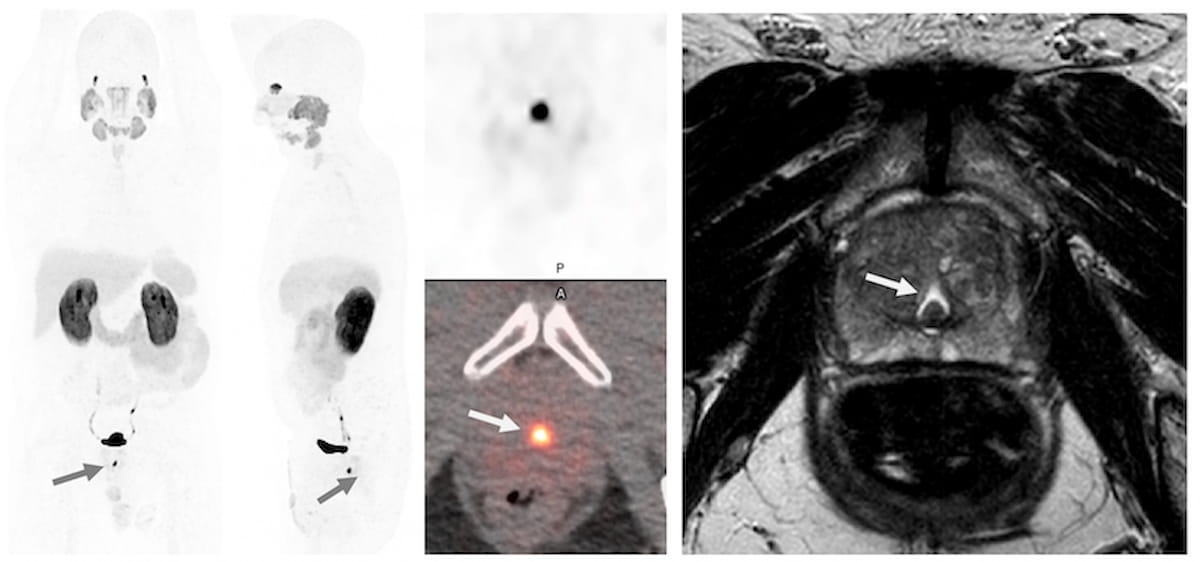What Post-Void MRIs May Reveal About Midline Radiotracer Activity on PSMA PET/CT
Patients with localized high-risk prostate cancer and midline radiotracer activity in the prostate had over double the incidence of urethral hyperintensity on T2W MRI, according to research presented at the American Society of Clinical Oncology (ASCO) Genitourinary Cancers Symposium (ASCO-GU).
Post-void magnetic resonance imaging (MRI) may provide enhanced clarity as to the nature of midline prostate-specific membrane antigen (PSMA) radiotracer uptake on positron emission tomography (PET) scans for patients with localized, high-risk prostate cancer.
In a study presented at the American Society of Clinical Oncology (ASCO) Genitourinary Cancers Symposium (ASCO-GU) in San Francisco, researchers reviewed PSMA PET and T2W MRI imaging for 84 patients with localized, high-risk prostate cancer. Sixty-eight patients had no midline prostate activity on PSMA PET and 16 patients who had had midline radiotracer activity with 18F-DCFPyL, according to the study.
The study authors found that 75 percent of patients with prostate midline tracer uptake on PSMA PET had urethral hyperintensity on post-void MRI exams in comparison to 31 percent of patients with no midline tracer activity on PSMA PET imaging.
For patients with urethral hyperintensity on post-void MRI exams, researchers noted significantly increased mean axial (7.25 mm vs. 2.81 mm) and sagittal (12.25 mm vs. 5.43 mm) prostatic urethral measurements in comparison to MRI findings for those with no prostate midline tracer uptake on PSMA PET imaging.
Here one can see PSMA PET/CT imaging that suggests a possible midline lesion and a subsequent MRI finding of urine stagnation. (Images courtesy of the American Society of Clinical Oncology (ASCO) Genitourinary Cancers Symposium.)

“Our findings suggest that PSMA uptake within the midline of the prostate is more commonly observed in patients with a prominently visible prostatic urethra at MRI, a finding that is likely associated with the stagnation of urine containing PSMA tracer,” wrote lead study author David G. Gelikman, an MRSP research scholar at the National Institutes of Health in Bethesda, Md., and colleagues.
The researchers emphasized that clinicians may misread PSMA activity within the prostatic urethra as intraprostatic lesions. Accordingly, they recommended subsequent assessment with MRI.
“PSMA uptake in the prostatic midline is often linked with urine stagnation in the prostatic urethra and can lead to misinterpretation on PSMA PET/CT,” noted Gelikman and colleagues. “Using post-void MRIs may help reduce false positives.”
Reference
1. Gelikman DG, Gonzalez EM, Lindenberg L, et al. Effect of urinary stagnation in the prostatic urethra on generating false-positive midline lesions on 18F-DCFPyL PSMA PET/CT. Poster presented at the 2024 American Society of Clinical Oncology (ASCO) Genitourinary Cancers Symposium (ASCO-GU, San Francisco, Calif. Poster available at https://conferences.asco.org/gu/abstracts . Accessed January 26, 2024.
What New Research Reveals About Novice Use of AI-Guided Cardiac Ultrasound
April 4th 2025In a study recently presented at the American College of Cardiology (ACC) conference, researchers found that novice use of AI-guided cardiac ultrasound after an AI-enabled electrocardiogram increased the positive predictive value for reduced left ventricular ejection fraction (LVEF) or aortic valve stenosis by 33 percent.
The Reading Room Podcast: Current Perspectives on the Updated Appropriate Use Criteria for Brain PET
March 18th 2025In a new podcast, Satoshi Minoshima, M.D., Ph.D., and James Williams, Ph.D., share their insights on the recently updated appropriate use criteria for amyloid PET and tau PET in patients with mild cognitive impairment.
GE HealthCare Debuts AI-Powered Cardiac CT Device at ACC Conference
April 1st 2025Featuring enhanced low-dose image quality with motion-free images, the Revolution Vibe CT system reportedly facilitates improved diagnostic clarity for patients with conditions ranging from in-stent restenosis to atrial fibrillation.
Expanded FDA Approval Allows Use of Pluvicto Prior to Chemotherapy in Patients with mCRPC
March 28th 2025Recent research demonstrated a 59 percent reduced risk of progression or death with the radioligand therapy Pluvicto in comparison to a change of androgen receptor pathway inhibitor (ARPI) for patients with metastatic castration-resistant prostate cancer (mCRPC).
New AI-Enabled Portable Ultrasound May Facilitate 50 Percent Reduction in Cardiac Imaging Scan Time
March 28th 2025Artificial intelligence (AI)-powered measurement capabilities provide key features with the Compact Ultrasound 5500CV device, which was unveiled at the American College of Cardiology (ACC) conference.